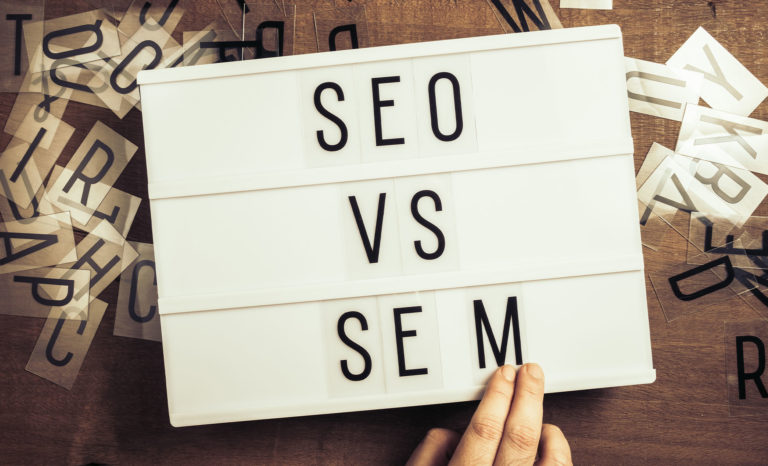

SEM vs SEO for Business: Which Is Better
Did you know that 68% of what people do online begins with a Google search? Because of this, it’s important for you as a business owner to be tech-savvy. You need to invest in digital marketing strategies that convert searches to clicks and clicks to sales.
SEO for business is one of the best ways to do this, but SEM is also a great way to gain traffic. Here, we’re going to talk about how each of these strategies works and help you determine which is right for you.
What Is SEO for Business?
Search engine optimization (SEO) is a long-term digital marketing strategy essential for business. It refers to the different things that you do both on your website and off of it to boost its visibility.
The goal is to make the page more appealing to search engine crawlers, the bots that decide how highly a page ranks in Google. Since 95% of people only click on sites that appear on the first page, this is critical.
Ultimately, SEO helps you to boost organic clicks. There are two main types of SEO: on-page and off-page SEO.
On-Page SEO
On-page SEO strategies are manipulations that you make to your website itself. The most common is the inclusion of high-volume keywords that you want your page to appear to searchers of.
Other on-page strategies include:
- Creating quality blog posts/other content that people want to read
- Optimizing your meta description
- Using internal linking to other areas of your webpage
- Title tag use
- SSL/HTTPS
- Alt text optimization
Off-Page SEO
Off-page SEO strategies are those that you perform on other areas of the web to boost your site rankings. The most commonly acknowledged one is backlinking, or including hyperlinks within the text on your website to other reputable pages. Search engine crawlers will then associate your page with these high-quality ones and place you higher in SERPs.
Other aspects of off-page SEO are:
- Listing your site on Google My Business (and other local listings)
- Generating traffic via inbound links from other sites
- Marketing on social media
- Building trust and reputation
- Getting good reviews (especially those that link back to you)
- Domain authority
How Is SEM Different?
SEO is built to create organic traffic, meaning that you aren’t paying for an advertisement to be displayed for people to click. Search engine marketing (SEM) is the opposite of SEO in that it’s a paid search strategy. You pay for your clicks.
Once you design a pay per click (PPC) ad, you can bid on a high-volume keyword that people search when looking for your services. You can use Google Analytics to see what search words people are typing in before they click on your page. Those that you see people hitting often but not always are the queries that you should focus on most.
Set your budget and your ad will be immediately displayed until your funds are depleted. People will see it either at the top of the search engine or in the sidebar. Mobile users may also see it at the bottom of the page as well as the top.
There’s no need to wait for the campaign to take effect. This is in contrast with SEO, which takes about 4-12 months to convert.
At the end of each PPC campaign, you can look into the metrics of which ads were clicked the most. Look for trends in their style or in the types of keywords that they displayed for. You can use this to make your next SEM campaign even more successful.
Which Is Right for You?
Deciding whether SEO or SEM is right for you is a tricky business. There are a lot of benefits to each.
If you’re looking for something that converts immediately, SEM is the answer. This is ideal for new businesses that are beginning the early stages of their digital marketing plan. You don’t want to wait for 4-12 months to get any customers clicking on your webpage.
SEO is the right choice, however, for those who need a more long-term growth strategy. While PPC ads expire when your budget is gone, SEO-rich blog posts never expire. Users will always find them when they look up the keywords that your posts were optimized for.
Additionally, SEO is cyclical. Well-optimized pages look good to Google crawlers and are therefore placed in a high SERPs position. More people click on it due to this prominent placing, which makes the page look even better to crawlers. It maintains its ranking (and even moves up) because of this.
Using SEO and SEM Together
SEO is pretty awesome for any business thinking long-term (which, let’s face it, all successful businesses are). But what about the long interval between your content’s creation and it becoming visible?
That’s why you need to use both SEO and SEM in tandem with one another. SEM gets people going to your website before SEO strategies take effect. You won’t need to wait an extremely long time to convert.
Additionally, people finding your site via PPC ads helps Google crawlers to recognize your page as reputable. When your SEO campaign does kick in, it will be more effective since crawlers already believe it to be a quality site.
You can also use SEM to generate leads for your future SEO content. Set up cookies that show you the queries that were most successful in bringing people to your site. These are keywords that you should be requesting next time you hire SEO content creators.
Launch Your Digital Marketing Strategy
Now that you know about SEO for business and how it differs from SEM, it’s time to get started.
Contact our digital marketing experts with any remaining questions you have about how to boost your business. We’re excited to help you take your visibility, leads, and sales to the next level, so don’t hesitate to reach out!



